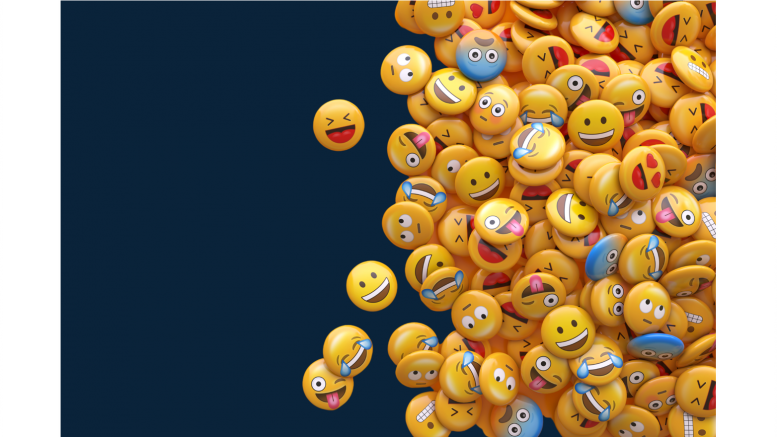‘A face with tears of joy’ rolling down! At last it was victory for the first ever emoji to be crowned as the 2015 Linguistic Champion!
Not an easy feat to being promoted from the ‘watchlist’ to the final pages of the Oxford Dictionary. A thumbs up to accepting emojis as a way of life which often expresses more than just words. Take that: Near 3790 emojis exist as per Emojipedia in  the Unicode Standard as of September 2024. And, deep diving into their social media usage, over 10 billion emojis are sent every day across the world further complementing the Gen Z & Gen Alpha lingo.
the Unicode Standard as of September 2024. And, deep diving into their social media usage, over 10 billion emojis are sent every day across the world further complementing the Gen Z & Gen Alpha lingo.
While this may seem like a frivolous use of time and resources, emojis can be a valuable communication tool.
Let’s de-humanise and study their WHY…
Business Messaging: A Pew Research Centre study (2023) found that emoji usage in business messages has increased by 775%. Brands use emojis in social media posts, email marketing campaigns, and advertisements to evoke emotions and create a relatable brand voice. Emojis also break the monotony of text, making content more visually appealing and shareable. Not only that, posts with emojis tend to have higher engagement rates, as they stand out in crowded feeds and encourage interactions.
Domino’s Pizza revolutionised the ordering process by allowing customers to order a pizza simply by tweeting a pizza emoji, significantly reducing the time it takes to place an order and providing instant gratification. Similarly, the World Wildlife Fund (WWF) created custom emojis of endangered animals to raise awareness about climate change and wildlife conservation, effectively using visual symbols to communicate their mission. McDonald’s capitalised on emojis in their advertisements to tell engaging stories and associate positive sentiments with their brand, making their messaging more relatable and memorable. Pepsi’s “Say it with Pepsi” campaign also utilised emojis to encourage social media users to share images, creating a fun and interactive platform for brand engagement. These examples only show the power of emoji connections with consumers.
Human Resources and Internal Communication: The ability of emojis to convey emotions and sentiments succinctly can enhance understanding and engagement thereby reducing the chances of misinterpretation in written messages. For instance, a simple smiley face can indicate positivity or friendliness, while a thumbs-up emoji can signify approval or agreement, making communication more effective and relatable
Their use can foster a more approachable and informal atmosphere, encouraging open dialogue and improved collaboration among team members. In hierarchical settings, emojis can help bridge people gap and, make leaders appear more relatable.
Customer Service
It’s estimated that 55% of our communication is body language, 38% is the tone of voice, and a mere 7% is the actual words used. Emojis are a great substitute here as they are essentially set the tone by using a digital form of body language!
Consider: if your company is experiencing shipping delays, you might send a message like:
“😔 We’re sorry, but parcel is delayed right now.”
versus
“Parcel is delayed right now.”
While both statements convey the same information, the first one feels more empathetic. The sad emoji indicates awareness of the inconvenience, suggesting that the company understands the situation is frustrating for the customer. In contrast, the second statement, though factual, comes off as harsh and detached, offering no context or acknowledgment of the customer’s feelings. Hence using emojis may even lead to customer loyalty and retention.
E-Learning
Since you are dealing with digital knowledge, emojis can compensate for the lack of personal presence. In e-learning courses, emojis can be used for assessments, feedback pop-ups when learners interact with either peers or the online teacher. Emojis can make content more relatable and fun and, are a useful tool when you want to say more with lesser words. For instance, using a light bulb emoji to indicate a new idea or concept. This not only makes learning more interactive but also helps in breaking down complex information into more digestible and relatable formats.
Demographics
Research suggests that age and gender are also correlated with emoji usage. For example, Generation Z is more likely to use emojis to convey irony, and gender is correlated with specific emoji usage. As regards gender, studies have found that females use more emoji and emoticons than males. A fact corroborated by a large-scale analysis of emoticons used on Facebook between 2007 and 2012.1
Can set the tone but not entirely replace…
Emojis, while often appearing simple, can be interpreted in varying ways depending on culture and context. For instance, a “Tired Face” emoji might represent frustration for some, while a ‘praying hands’ emoji may be mistaken for a high-five in certain cultures. Regional differences also play a role, such as Indonesian businesses favouring toothy smiles, while American companies prefer closed-mouth emojis. Due to these potential misunderstandings, it’s important to avoid emojis with varied connotations in business settings.
Emojis are naturally friendly and informal, but this can make them unsuitable in serious or sensitive situations. In such cases, their light-hearted tone can come across as unprofessional, so it’s crucial to gauge the context before using them.
The platform also matters when using emojis. More informal platforms like Live Chat or Twitter are ideal for emoji usage, as these environments thrive on real-time, casual communication. In contrast, emails—especially customer service ones—might need a more restrained approach, though emojis can be effective in marketing emails to boost engagement.
The growing use of emojis highlights their versatility in improving communication. Emojis convey emotions, boost engagement, and help bridge the gap between formal and informal communication. As workplaces and markets evolve, the strategic use of emojis will continue to shape how organizations connect with clients, teams, and communities because after all a picture is worth thousand words…
The views and opinions published here belong to the author and do not necessarily reflect the views and opinions of the publisher.



Be the first to comment on "Talk Human, Speak Emotion"